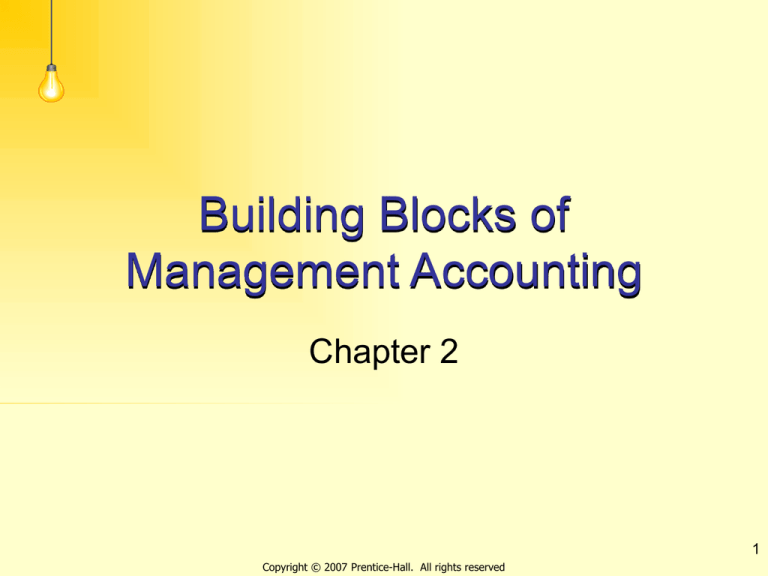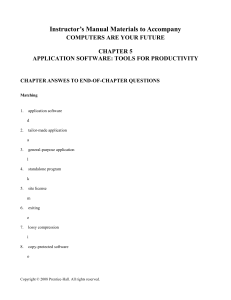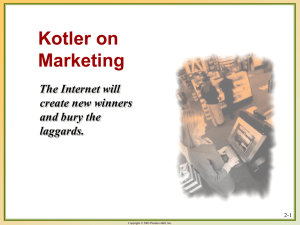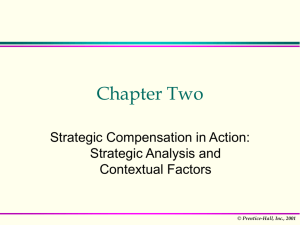
Building Blocks of
Management Accounting
Chapter 2
1
Copyright © 2007 Prentice-Hall. All rights reserved
Objective 1
Distinguish among service,
merchandising, and
manufacturing companies
2
Copyright © 2007 Prentice-Hall. All rights reserved
Service Companies
• Sell services
• No inventory or cost of goods sold
accounts
• Labor costs – incurred to develop new
services, advertise, provide customer
service
3
Copyright © 2007 Prentice-Hall. All rights reserved
Merchandising Companies
• Purchase inventory from suppliers; resell
to customers
• Retailers and wholesalers
• One inventory account – includes all costs
to acquire and get inventory ready for sale
• Labor costs – identify new products and
locations for stores, advertising, selling,
customer service
4
Copyright © 2007 Prentice-Hall. All rights reserved
Manufacturing Companies
• Use labor, plant, and equipment to convert raw
materials into finished products
• Three inventory accounts
– Raw Materials inventory
– Work in process inventory
– Finished goods inventory
5
Copyright © 2007 Prentice-Hall. All rights reserved
Objective 2
Describe the value chain and its
elements
6
Copyright © 2007 Prentice-Hall. All rights reserved
Value Chain
• Activities that add value to products and
services
R&D
Design
Production/
Purchases
Customer
Service
Distribution
Marketing
7
Copyright © 2007 Prentice-Hall. All rights reserved
E2-16
Samsung Electronics
Cost Classification
Production
R&D
Design
Direct
Mat.
Direct
Labor
MOH
Distrib.
$65
Depreciation on P&E
$ 6
Exterior case
$12
$ 7
Delivery expense
61
Transmitters
$ 2
Rearrange process
$10
Assembly-line workers’ wages
$ 3
Tech support hotline
1
Toll free line for customer orders
Total costs
Cust.
Service
$ 5
Salaries of telephone salespeople
Scientists’ salaries
Market.
$12
$ 2
$67
$10
$65
$ 6
$ 7
$ 3
8
Copyright © 2007 Prentice-Hall. All rights reserved
Objective 3
Distinguish between direct and indirect
costs and identify the inventoriable
product costs and period costs of
merchandising and manufacturing firms
9
Copyright © 2007 Prentice-Hall. All rights reserved
Cost Object
• Anything for which managers want a
separate measurement of cost
– Direct cost – can be traced directly to cost
object
– Indirect cost – can not be traced directly to
cost object
10
Copyright © 2007 Prentice-Hall. All rights reserved
Determining Total Costs
Assign direct and
indirect costs to
cost object
Trace direct costs
Allocate
indirect costs
11
Copyright © 2007 Prentice-Hall. All rights reserved
Product Costs
Two definitions
1. Full product costs (internal decision
making) - all resources used throughout
value chain
2. Inventoriable product costs (external
reporting) – costs incurred during
production or purchases stage of value
chain
12
Copyright © 2007 Prentice-Hall. All rights reserved
Inventoriable Product Costs
R&D
Customer
Service
Inventoriable
ProductDesign
Costs
Distribution
Production/
Purchases
Marketing
Period Costs
13
Copyright © 2007 Prentice-Hall. All rights reserved
2007
Product
costs
Operating
expenses
2007
Income
Statement
14
Copyright © 2007 Prentice-Hall. All rights reserved
Inventory
sold in
2007
2007
Product
costs
Cost of
goods
sold
2007
Income
Statement
2007
Balance
Sheet
Inventory
Inventory
sold in
2008
Cost of
goods
sold
2008
Income
Statement
15
Copyright © 2007 Prentice-Hall. All rights reserved
Merchandising Company
Product Costs
• Purchase price plus cost of getting
merchandise ready for sale
16
Copyright © 2007 Prentice-Hall. All rights reserved
Manufacturing Company
Product Costs
• Direct materials
Direct Costs
• Direct labor
Indirect Costs
• Manufacturing overhead
17
Copyright © 2007 Prentice-Hall. All rights reserved
Manufacturing Overhead
• Indirect costs related to manufacturing
operations
– Generally all manufacturing costs that are not
direct costs
– Indirect materials
– Indirect labor
18
Copyright © 2007 Prentice-Hall. All rights reserved
Prime and Conversion Costs
Direct
Materials
Direct
Labor
Prime Costs
Manufacturing
Overhead
Conversion
Costs
19
Copyright © 2007 Prentice-Hall. All rights reserved
Direct & Indirect Labor
Compensation
• Salaries & wages
• Fringe benefits
• Payroll taxes
20
Copyright © 2007 Prentice-Hall. All rights reserved
E2-19
DM
a. Airplane seats
DL
IM
IL
Other
MOH
250
b. Depr. on admin
offices
60
c. Assembly workers’
wages
600
d. Plant utilities
120
e. Prod. supervisors’
salaries
f. Jet engines
g. Machine lubricants
Period
100
1,000
15
h. Depreciation on
forklifts
50
21
Copyright © 2007 Prentice-Hall. All rights reserved
E2-19
DM
DL
IM
Other
MOH
IL
i. Prop tax on corp
marketing offices
25
j. Cost of warranty
repairs
225
k. Factory janitors’
wages
30
l. Designing new plant
layout
175
m. Machine operators
health insurance
TOTAL
Period
40
1,250
640
15
130
170
485
22
Copyright © 2007 Prentice-Hall. All rights reserved
E2-19
2) Total manufacturing overhead costs =
IM +IL + Other MOH=
$15 + 130 + 170 = $315
3) Total inventoriable product costs =
DM + DL +MOH =
$1,250 + 640 +315 = $2,205
23
Copyright © 2007 Prentice-Hall. All rights reserved
E2-19
4) Total prime costs = DM + DL =
$1,250 + 640 = $1,890
5) Total conversion costs = DL + MOH =
$640 + 315 = $955
6) Total period costs = $485
24
Copyright © 2007 Prentice-Hall. All rights reserved
Objective 4
Prepare the financial statements for service,
merchandising, and manufacturing companies
25
Copyright © 2007 Prentice-Hall. All rights reserved
Service Company
• All costs are period costs
• Operating income = Service revenue –
operating expenses
26
Copyright © 2007 Prentice-Hall. All rights reserved
Merchandising Company –
Income Statement
Sales
- Cost of goods sold
Gross profit
- Operating expenses
Operating income
27
Copyright © 2007 Prentice-Hall. All rights reserved
Merchandising Company – .
Income Statement
Cost of goods sold:
Beginning inventory
+ Purchases
+ Freight-in
Cost of goods available for sale
- Ending inventory
Cost of goods sold
28
Copyright © 2007 Prentice-Hall. All rights reserved
Manufacturing Companies –
Income Statement
Sales
- Cost of goods sold
Gross profit
- Operating expenses
Operating income
29
Copyright © 2007 Prentice-Hall. All rights reserved
Manufacturing Company –
Income Statement
Cost of goods sold:
Beginning finished goods inventory
+ Cost of goods manufactured
Cost of goods available for sale
- Ending finished goods inventory
Cost of goods sold
30
Copyright © 2007 Prentice-Hall. All rights reserved
Manufacturing Company –
Income Statement
Cost of goods manufactured:
Beginning work in process inventory
+ Direct materials used
+ Direct labor
+ Manufacturing overhead
Total manufacturing costs to account for
- Ending work in process inventory
Cost of goods manufactured
31
Copyright © 2007 Prentice-Hall. All rights reserved
Manufacturing Company –
Income Statement
Direct materials used:
Beginning materials inventory
+ Purchases of direct materials
+ Freight in
Materials available for use
- Ending materials inventory
Direct materials used
32
Copyright © 2007 Prentice-Hall. All rights reserved
Manufacturing Companies
Product & Period Costs
BALANCE SHEET
Inventoriable
Product Costs
Materials
Inventory
Work in
Process
Inventory
Finished
Goods
Inventory
INCOME STATEMENT
when
sales
occur
Sales
-
Cost of
Goods Sold
Operating
Expenses
=
Operating Income
Period
Costs
33
Copyright © 2007 Prentice-Hall. All rights reserved
Manufacturing Companies
Inventory Accounts
Materials Inventory
Beginning inventory
Materials used
Purchases & freight
Ending inventory
34
Copyright © 2007 Prentice-Hall. All rights reserved
Manufacturing Companies
Inventory Accounts
Work in Process
Inventory
Beginning inventory
Materials used
Cost of goods
manufactured
Direct labor
Manufacturing overhead
Ending inventory
35
Copyright © 2007 Prentice-Hall. All rights reserved
Manufacturing Companies
Inventory Accounts
Finished Goods
Inventory
Beginning inventory
Cost of goods
manufactured
Cost of goods
sold
Income Statement
Ending inventory
36
Copyright © 2007 Prentice-Hall. All rights reserved
E2-21
Strike Company
Statement of Cost of Goods Manufactured
For Year Ended December 31, 2007
Beginning work in process inventory
$50,000
Direct materials used:
Beginning materials inventory
$25,000
Purchases of direct materials
78,000
Materials available for use
$103,000
Ending materials inventory
(28,000)
75,000
Direct labor
82,000
Manufacturing overhead (see schedule)
41,000
Total manufacturing costs to account for
$248,000
Ending work in process inventory
(35,000)
Cost of goods manufactured
$213,000
37
Copyright © 2007 Prentice-Hall. All rights reserved
E2-21
Cost of goods sold:
Finished goods inventory, January 1
Cost of goods manufactured
Goods available for sale
Finished goods inventory, December 31
Cost of goods sold
$18,000
213,000
$231,000
(25,000)
$206,000
39
Copyright © 2007 Prentice-Hall. All rights reserved
E2-22
Strike Marine Company
Income Statement
For Year Ended December 31, 2007
Sales
Cost of goods sold
Gross profit
Operating expenses:
Marketing expenses
General and administrative expenses
Income before income tax
Income tax expense
Net income
$384,000
206,000
$178,000
$77,000
29,000 106,000
$72,000
23,000
$49,000
40
Copyright © 2007 Prentice-Hall. All rights reserved
E2-19
a. Direct
__________
costs can be traced to cost
objects.
b. Period
____________
costs are expensed when
incurred.
c. Prime
_____ are the combination of direct
materials and direct labor.
d. Compensation includes wages, salaries,
fringe benefits
and _________________.
41
Copyright © 2007 Prentice-Hall. All rights reserved
E2-18
e. Inventoriable
________________________
product costs are
treated as _______until
sold.
assets
f. Inventoriable
________________________
product costs include
costs from only the production or
purchases element of the value chain.
g. Indirect
_____________are
allocated to cost
costs
objects.
h. Both direct and indirect costs are assigned
______
to ________________.
cost objects
42
Copyright © 2007 Prentice-Hall. All rights reserved
E2-18
i. Full
__________________
include costs
product costs
from every element of the value chain.
j. Conversion
__________________
are the
costs
combination of direct labor and
manufacturing overhead.
product costs are
k. Inventoriable
_________________________
expensed as
__________________when
sold.
cost
of goods sold
43
Copyright © 2007 Prentice-Hall. All rights reserved
E2-18
l. Manufacturing overhead includes all
indirect costs of production.
______________
44
Copyright © 2007 Prentice-Hall. All rights reserved
Objective 5
Describe costs that are relevant and
irrelevant for
decision making
45
Copyright © 2007 Prentice-Hall. All rights reserved
Controllable vs Uncontrollable
Costs
• Controllable – management can influence
or change cost
• Uncontrollable – management cannot
change or influence cost in the short-run
46
Copyright © 2007 Prentice-Hall. All rights reserved
Relevant and Irrelevant Costs
• Relevant – costs that differ between
alternatives – differential costs
• Irrelevant – costs that do not differ
– Sunk costs
47
Copyright © 2007 Prentice-Hall. All rights reserved
Objective 6
Classify costs as fixed or variable
and calculate total and
average costs at different volumes
48
Copyright © 2007 Prentice-Hall. All rights reserved
Cost Behavior
• Variable costs
• Fixed costs
49
Copyright © 2007 Prentice-Hall. All rights reserved
Total Variable Costs
Total Sales
Commissions
Assume we pay 5% sales commissions on
all sales. The cost of sales commissions
increase proportionately with increases in
$2,500
sales.
$2,000
$1,500
$1,000
$500
$0
$0
$10,000 $20,000 $30,000 $40,000
Total Sales
50
Copyright © 2007 Prentice-Hall. All rights reserved
Total Sales Salaries
Total Fixed Costs
$2,500
$2,000
$1,500
$1,000
$500
$0
$0
$10,000 $20,000 $30,000 $40,000
Total Sales
51
Copyright © 2007 Prentice-Hall. All rights reserved
Total Cost
Total fixed costs
+ Variable cost per unit x number of units
Total Cost
52
Copyright © 2007 Prentice-Hall. All rights reserved
Average Cost
Total cost ÷ number of units
53
Copyright © 2007 Prentice-Hall. All rights reserved
Marginal Cost
• Cost of making one more unit
54
Copyright © 2007 Prentice-Hall. All rights reserved
E2-24
a. Managers cannot influence uncontrollable
__________
_____
costs in the short-run.
b. Total _____________
variable costs decrease when
production volume decreases.
c. For decision-making purposes, costs that
do not differ between alternatives are
irrelevant costs
________________.
d. Costs that have already been incurred are
called ____________.
sunk costs
55
Copyright © 2007 Prentice-Hall. All rights reserved
E2-24
e. Total ___________
fixed costs stay constant over a
wide range of production volume.
f. The _______________
differential cost is the difference
in cost between two alternative courses
of action.
marginal cost is the cost
g. The product’s ____________
of making one more unit.
56
Copyright © 2007 Prentice-Hall. All rights reserved
E2-24
h. A product’s ____________
fixed costs
and
variable
costs not the product’s
____________,
___________,
average
cost should used to forecast
total costs at different production
volumes.
57
Copyright © 2007 Prentice-Hall. All rights reserved
E2-25
a. Total product cost =
$1 x 20,000,000
$20,000,000
5,000,000
$25,000,000
b. Average cost =
$25,000,000/20,000,000 = $1.25
58
Copyright © 2007 Prentice-Hall. All rights reserved
E2-25
c. Fixed cost per unit =
$5,000,000 ÷ 20,000,000 = $.25
d. Forecasted product cost =
$1 x 25,000,000
$25,000,000
5,000,000
$30,000,000
59
Copyright © 2007 Prentice-Hall. All rights reserved
E2-25
e. Forecasted average product cost =
$30,000,000 ÷ 25,000,000
$1.20
f. Forecasted fixed cost
$5,000,000 ÷ 25,000,000
$.20
60
Copyright © 2007 Prentice-Hall. All rights reserved
E2-25
g. The average product cost decreases as
production volume increases because the
company is spreading its fixed costs over
5 million more units. The company will be
operating more efficiently, so the average
cost of making each unit decreases.
61
Copyright © 2007 Prentice-Hall. All rights reserved
End of Chapter 2
62
Copyright © 2007 Prentice-Hall. All rights reserved









